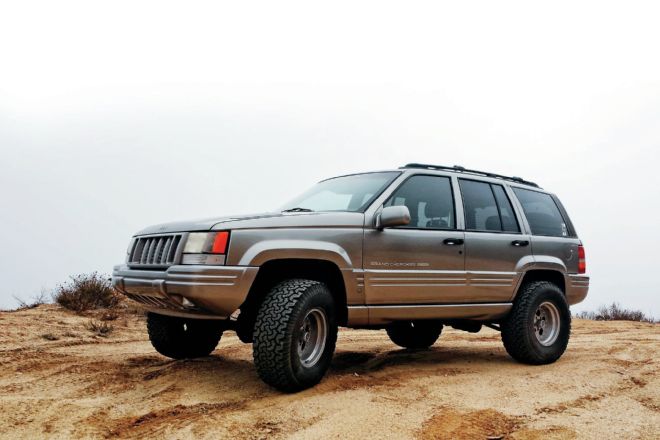
 Pete Trasborg
Brand Manager, Jp
Pete Trasborg
Brand Manager, Jp
This is one of those “do as we say, not as we do” kind of stories. We recently had a chance to grab a ’98 5.9L Limited Grand Cherokee ZJ. We’ve been chasing this particular Jeep for about seven years now.
We got it from Jeeps R Us in Laguna Beach, California, and basically picked it up sight unseen. Obviously, we saw it, but we didn’t really crawl under it, look at anything but the interior, etc. The owner’s wife had been driving it, and at 150,000 miles, it was in amazing shape. It actually still is. Ham-fisted Trasborg still hasn’t managed to kill it (yet).
However, the Jeep hadn’t been driven in a while, and we just didn’t care. It was a low-mileage, cream-puff, 5.9L Limited. Who would care?
Well, we brought it home, and once we started driving it—or Trasborg started beating on it (whichever way you want to phrase it)—some issues showed up, and here’s the do-as-we-say part: It’s nothing wrong with Jeeps R Us; they sell great Jeeps that are often hard to find anywhere else and do great work restoring a Jeep. However, not driving a Jeep might be worse for it than letting Trasborg take it and run over a medicine-ball-sized boulder at 60 mph.
OK, maybe we’re exaggerating a bit. We bent the control arm on that 60 mph stunt, put the upper control arm mount into the oil filter housing, drained the engine of all its oil, and spent a total of 18 hours and 60 miles on a strap getting the Jeep home. The point: Drive your Jeeps if you don’t want them to die.
To clarify, we didn’t wreck this Grand, but once we started driving it again, we noticed some issues that wouldn’t have happened if it had been driven by anyone but Trasborg. You know, also known as “driven it normally.” Simply put, if you don’t drive the Jeep every day, it is easy to forget about some issues it may or may not have. Thankfully, Jeeps R Us offered to take care of any issue we had. Most normal people wouldn’t even call some of these things issues.
But us being us, we took them as “excuses” to upgrade the Jeep. So, here are some common Grand Cherokee issues and some of the things we did to take care of them. Oh, by the way, never buy a Jeep from us. We have so many of them they sit for years sometimes. We’ve been thinking of hiring someone just to drive our Jeeps so they don’t die.
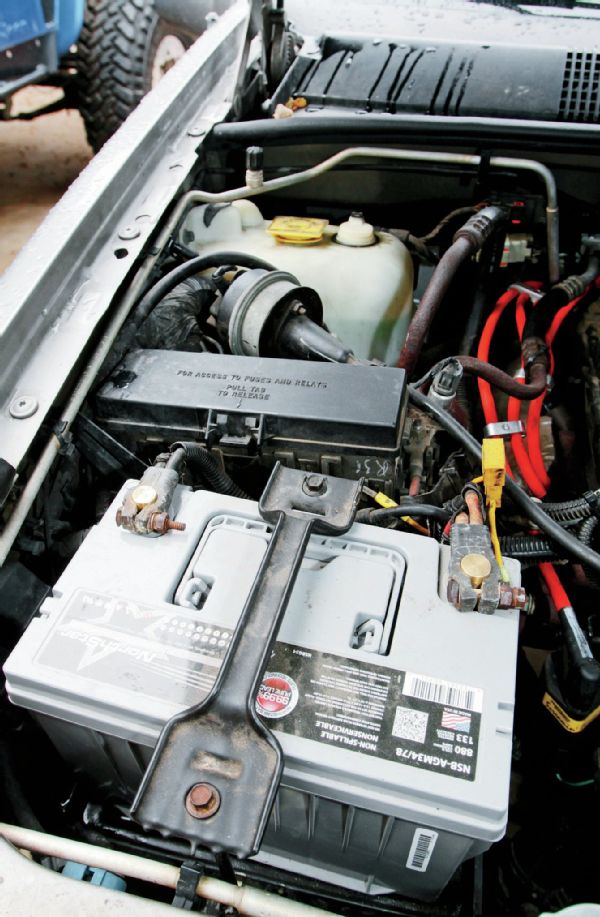 The Limited-trim ZJs have those goofy information clusters in them. We basically ignore them or rip them out before driving over them. So when the new Jeep’s information cluster started spazzing out about “check battery,” we just ignored it. Turns out the battery really was getting weak. Once we figured it out, we replaced the old open-cell battery with this Northstar battery from West Coast Batteries. Poof! Problem solved.
The Limited-trim ZJs have those goofy information clusters in them. We basically ignore them or rip them out before driving over them. So when the new Jeep’s information cluster started spazzing out about “check battery,” we just ignored it. Turns out the battery really was getting weak. Once we figured it out, we replaced the old open-cell battery with this Northstar battery from West Coast Batteries. Poof! Problem solved.
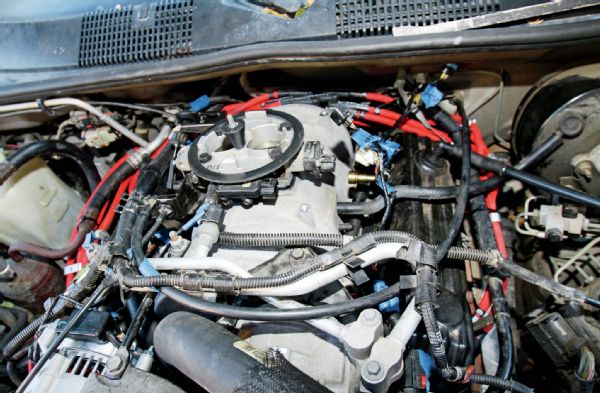 After we got it back up and running again, we noticed a slight puff of blue smoke when we started it up. That led to us having the suspicion that maybe we were burning oil. After the first 3,000 miles, we knew we were. A common problem with these Magnum V-8s is the two-piece intake manifold. Basically the bottom of the intake manifold where the lifter valley is located is a piece of bolted-on sheetmetal. Over time, that can warp (thanks to the heating and cooling), and it tends to let the gasket leak or just completely blow out. So the solution is a 1⁄4-inch-thick aluminum plate from Hughes Engine. It comes with all new bolts too.
After we got it back up and running again, we noticed a slight puff of blue smoke when we started it up. That led to us having the suspicion that maybe we were burning oil. After the first 3,000 miles, we knew we were. A common problem with these Magnum V-8s is the two-piece intake manifold. Basically the bottom of the intake manifold where the lifter valley is located is a piece of bolted-on sheetmetal. Over time, that can warp (thanks to the heating and cooling), and it tends to let the gasket leak or just completely blow out. So the solution is a 1⁄4-inch-thick aluminum plate from Hughes Engine. It comes with all new bolts too.
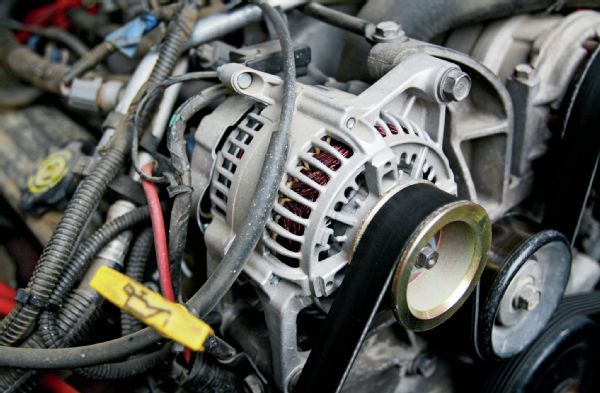 Or so we thought until we got the same error message again. And then the Jeep wouldn’t start. Now we were super confused. We just replaced the battery with a kick-ass AGM battery. What could it be? Then the alternator came apart and even our dumb asses could figure it out. Fortunately for us, it came apart in front of a local parts store making it easy for us to fix. Walk in, buy alternator. The 5.9L Grand had a higher-output alternator to begin with, so of course we went with this 165-amp alternator.
Or so we thought until we got the same error message again. And then the Jeep wouldn’t start. Now we were super confused. We just replaced the battery with a kick-ass AGM battery. What could it be? Then the alternator came apart and even our dumb asses could figure it out. Fortunately for us, it came apart in front of a local parts store making it easy for us to fix. Walk in, buy alternator. The 5.9L Grand had a higher-output alternator to begin with, so of course we went with this 165-amp alternator.
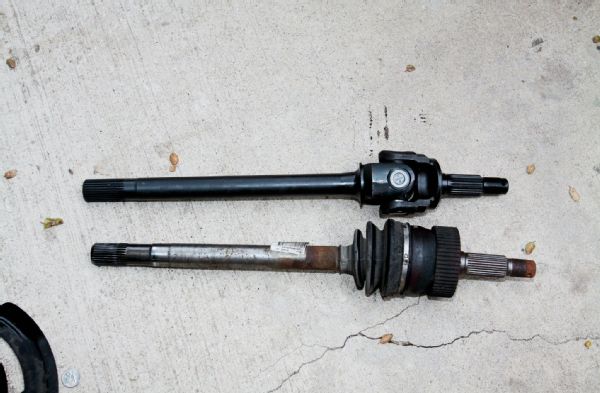 And yet another issue came up: There was a clicking coming from under the front of the Jeep. The 5.9L Limited has a full-time NV249 T-case, so the front axle is always engaged. Well, we were able to chase the noise down to the front axleshafts pretty quickly since it only made the noise when we were turning left. We had the paperwork that showed when the ’shafts had been replaced before, and they barely had 30,000 miles on them. So again, we took the opportunity to upgrade them with these Revolution and Gear chromoly ’shafts.
And yet another issue came up: There was a clicking coming from under the front of the Jeep. The 5.9L Limited has a full-time NV249 T-case, so the front axle is always engaged. Well, we were able to chase the noise down to the front axleshafts pretty quickly since it only made the noise when we were turning left. We had the paperwork that showed when the ’shafts had been replaced before, and they barely had 30,000 miles on them. So again, we took the opportunity to upgrade them with these Revolution and Gear chromoly ’shafts.
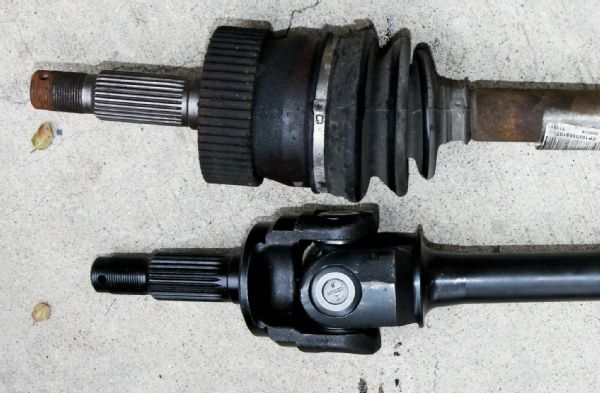 The new ’shafts have regular U-joints in place of the factory CVs that always seem to blow up with bigger tires. From the factory, the OE CVs work fine, but add bigger tires and more power and pop! So, we now have the more standard U-joints in our front axle. As a cool bonus, they are only made in the USA.
The new ’shafts have regular U-joints in place of the factory CVs that always seem to blow up with bigger tires. From the factory, the OE CVs work fine, but add bigger tires and more power and pop! So, we now have the more standard U-joints in our front axle. As a cool bonus, they are only made in the USA.
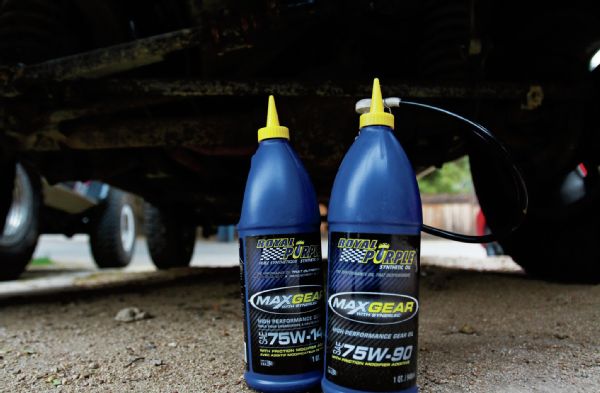 While we were at it, we went through the axles. We checked the gear oil and it was pretty nasty. So, we pulled the differential covers off and then subsequently refilled them with Royal Purple gear oil. With the oil’s added additive package we should be good to go for another 150,000 miles.
While we were at it, we went through the axles. We checked the gear oil and it was pretty nasty. So, we pulled the differential covers off and then subsequently refilled them with Royal Purple gear oil. With the oil’s added additive package we should be good to go for another 150,000 miles.
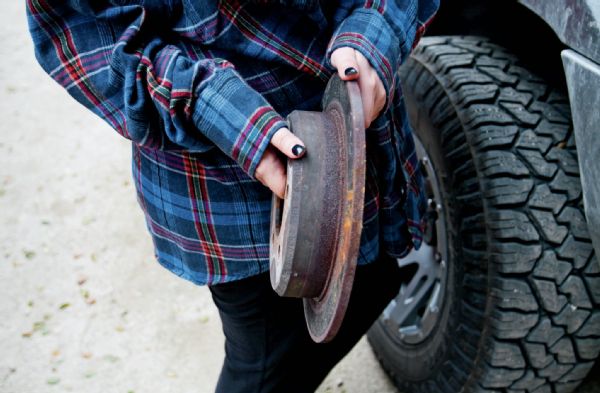 We also noticed the rear brakes needed some help too. The parking brake was catching kind of high, so we adjusted it, but that didn’t help. So we pulled the rear brakes apart to root around in there with a stick and found that they were pretty much done. One thing then led to another.
We also noticed the rear brakes needed some help too. The parking brake was catching kind of high, so we adjusted it, but that didn’t help. So we pulled the rear brakes apart to root around in there with a stick and found that they were pretty much done. One thing then led to another.
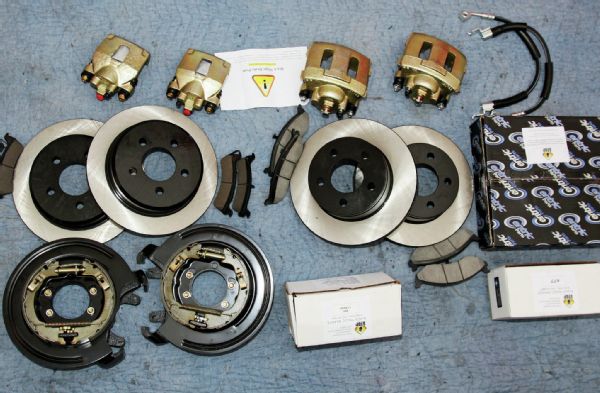 So, after some conversations with a few aftermarket manufacturers, we opted to go with Black Magic brakes. We wanted more stopping power and wanted them to be quiet, yet work with the factory anti-lock braking system, as we weren’t going to be beating this Jeep up. Black Magic knew exactly what we were talking about and provided us with front and rear brakes, and we were able retain the factory ABS.
So, after some conversations with a few aftermarket manufacturers, we opted to go with Black Magic brakes. We wanted more stopping power and wanted them to be quiet, yet work with the factory anti-lock braking system, as we weren’t going to be beating this Jeep up. Black Magic knew exactly what we were talking about and provided us with front and rear brakes, and we were able retain the factory ABS.
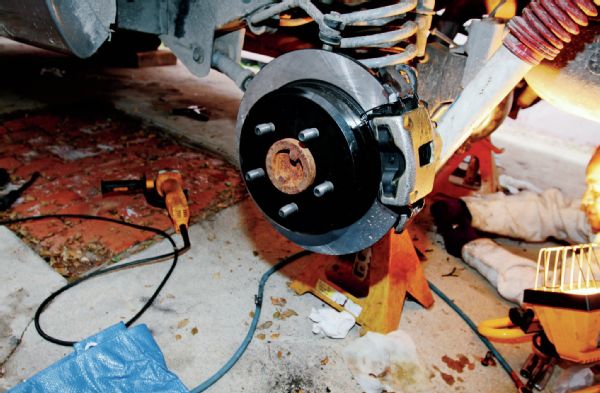 In the rear, Black Magic Brakes actually provided us with a complete set of TJ brakes as an upgrade to the factory brakes, but we couldn’t use the backing plates because we couldn’t get our axleshafts through the holes. So, we actually took the new brake components and installed them on our factory backing plates, minus the anti-rattle clips since they wouldn’t fit.
In the rear, Black Magic Brakes actually provided us with a complete set of TJ brakes as an upgrade to the factory brakes, but we couldn’t use the backing plates because we couldn’t get our axleshafts through the holes. So, we actually took the new brake components and installed them on our factory backing plates, minus the anti-rattle clips since they wouldn’t fit.
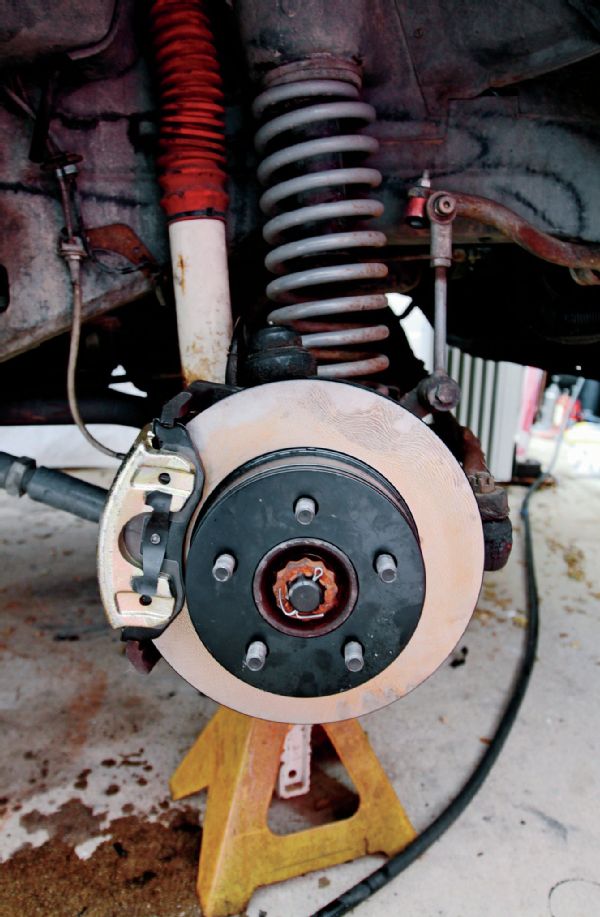 Up front, new rotors, pads, and calipers completed the setup. Our calipers were sticky, and the result was that the inside of the rotor was way more worn than the outside. At the end of all of this (and after following Black Magic’s break-in instructions), we have much better brakes than before. The brakes actually work with our factory ABS and bring this Jeep with 32-inch tires to a stop way faster than it probably has since it left the factory.
Up front, new rotors, pads, and calipers completed the setup. Our calipers were sticky, and the result was that the inside of the rotor was way more worn than the outside. At the end of all of this (and after following Black Magic’s break-in instructions), we have much better brakes than before. The brakes actually work with our factory ABS and bring this Jeep with 32-inch tires to a stop way faster than it probably has since it left the factory.